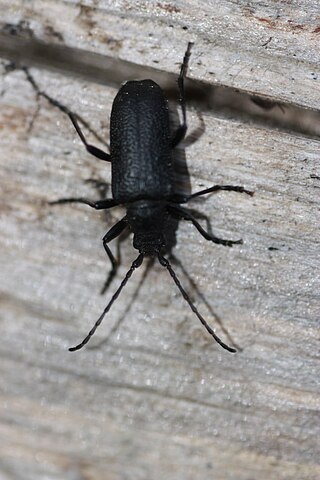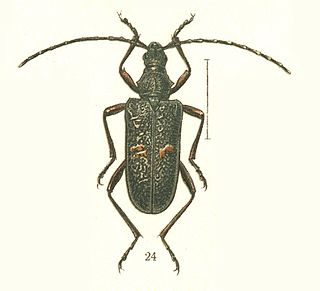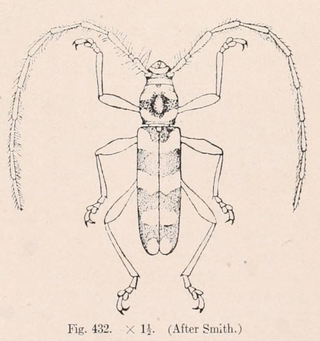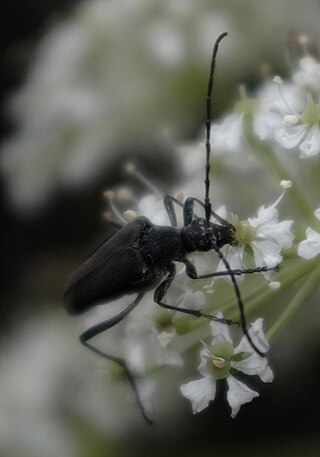
Pleocoma is the only extant genus of rain beetles and is endemic to the Pacific states of North America. Fossil remains of Pleocoma have been found in the Yixian Formation in China, suggesting beetles in this genus have existed in something like their present form since at least the Cretaceous period. There are 27 described species in Pleocoma.

Cerambycinae is a subfamily of the longhorn beetle family (Cerambycidae). The subfamily has a world-wide distribution including: Asia, Europe and the Americas. Within the family, the only subfamily of comparable diversity is the Lamiinae.

Lepturinae, the lepturine beetles, is a subfamily of the longhorn beetle family (Cerambycidae), containing about 150 genera worldwide. This lineage is most diverse in the Northern Hemisphere. Until recently the subfamily Necydalinae was included within the lepturines, but this has been recently recognized as a separate subfamily. Nine tribes are usually recognized today, with a tenth, Caraphiini, created in 2016. A few genera are of uncertain placement within the subfamily.

Neanthophylax tenebrosus is a species in the longhorn beetle family Cerambycidae, found in United States. The adult beetles feed on mountain hemlock and red fir.

Eutrichillus is a genus of longhorn beetles of the subfamily Lamiinae. It was described by Henry Walter Bates in 1885.

Sternidius is a genus of flat-faced longhorns in the family of beetles known as Cerambycidae. There are at least 20 described species in Sternidius.

Neanthophylax is a genus in the longhorn beetle family Cerambycidae. There are at least four described species in Neanthophylax.

Sachalinobia is a genus of flower longhorns in the beetle family Cerambycidae. There are at least two described species in Sachalinobia.

Callidiini is a tribe of longhorn beetles in the family Cerambycidae. There are more than 30 genera and 180 described species in Callidiini.

Phymatodes is a genus of longhorn beetles in the family Cerambycidae. There are more than 50 described species in Phymatodes, found throughout much of the norther hemisphere.

Trachyderini is a tribe of long-horned beetles in the family Cerambycidae. There are at least 140 genera and 650 described species in Trachyderini.
Dorcasina matthewsii is a species of flower longhorn in the beetle family Cerambycidae. It is found in North America and was described by John Lawrence LeConte in 1869.
Zagymnus clerinus is a species of longhorn beetle in the subfamily Cerambycinae. It was described by John Lawrence LeConte in 1873. It is known from the US states of Georgia and Florida and from Cuba.
Phymatodes aeneus is a species of longhorn beetle in the family Cerambycidae, found in North America.
Phymatodes ater is a species of longhorn beetle in the family Cerambycidae. It is found in North America.

Dryobius sexnotatus is a species of beetle in the family Cerambycidae. It is the only species in the monospecific genus Dryobius.

Synaphaeta is a monotypic beetle genus in the family Cerambycidae first described by Thomson in 1864. Its only species, Synaphaeta guexi, occurs in the Pacific states of North America, from British Columbia down to California. It has been reared from a variety of hardwood trees, including Pacific willow , white alder , coffeeberry , English walnut , and cherry . It was described by John Lawrence LeConte in 1852 based on a specimen from Benicia, California.
Typocerus deceptus is a species of flower longhorn in the family Cerambycidae. It is found in North America.

Trachysida aspera is a species of flower longhorn in the beetle family Cerambycidae. It is found in North America.

Tetropium is a genus of long-horned beetles in the family Cerambycidae. There are at least 20 described species in Tetropium. The genus is sometimes classified in its own monotypic tribe, Tetropiini.














